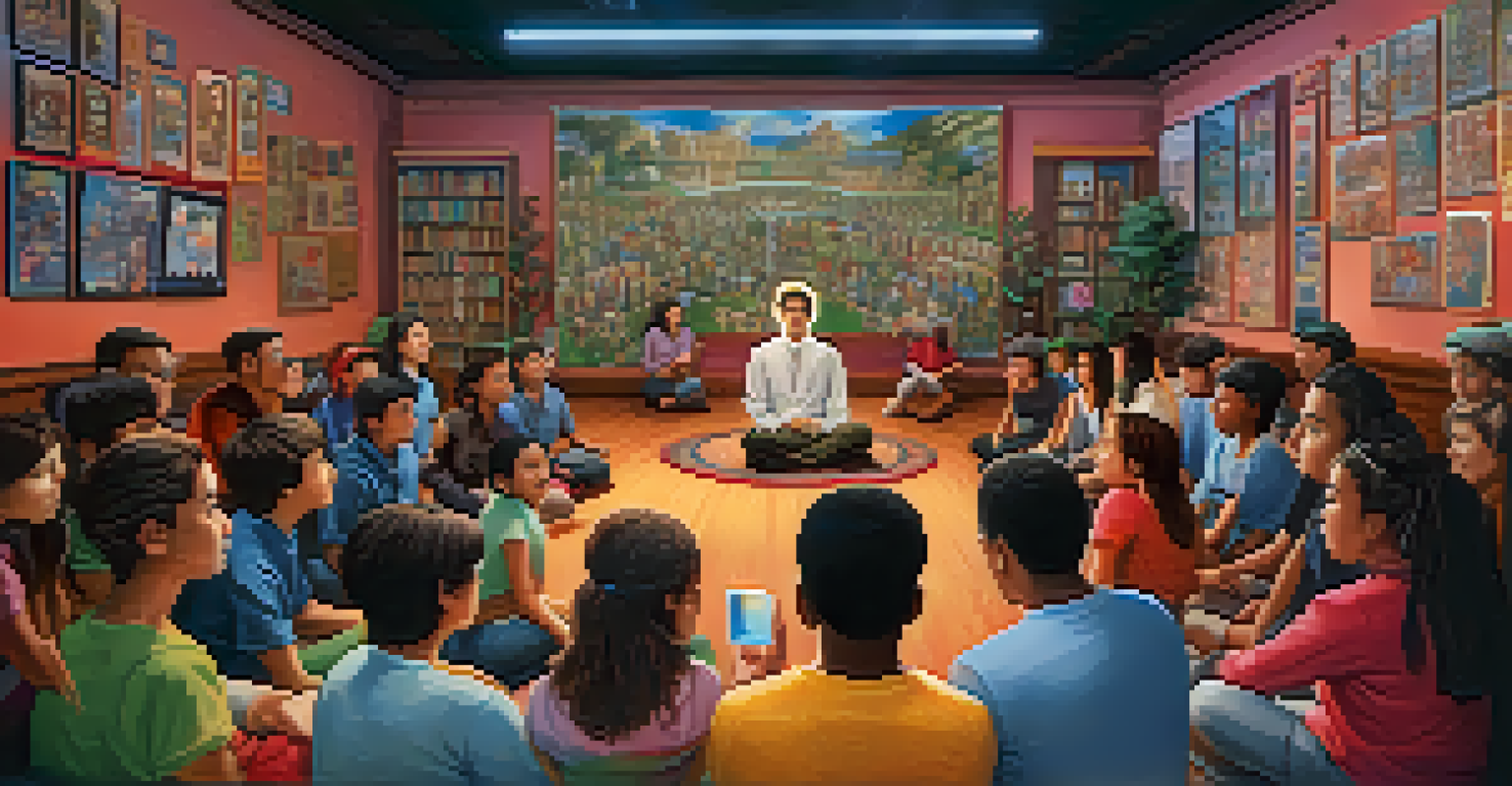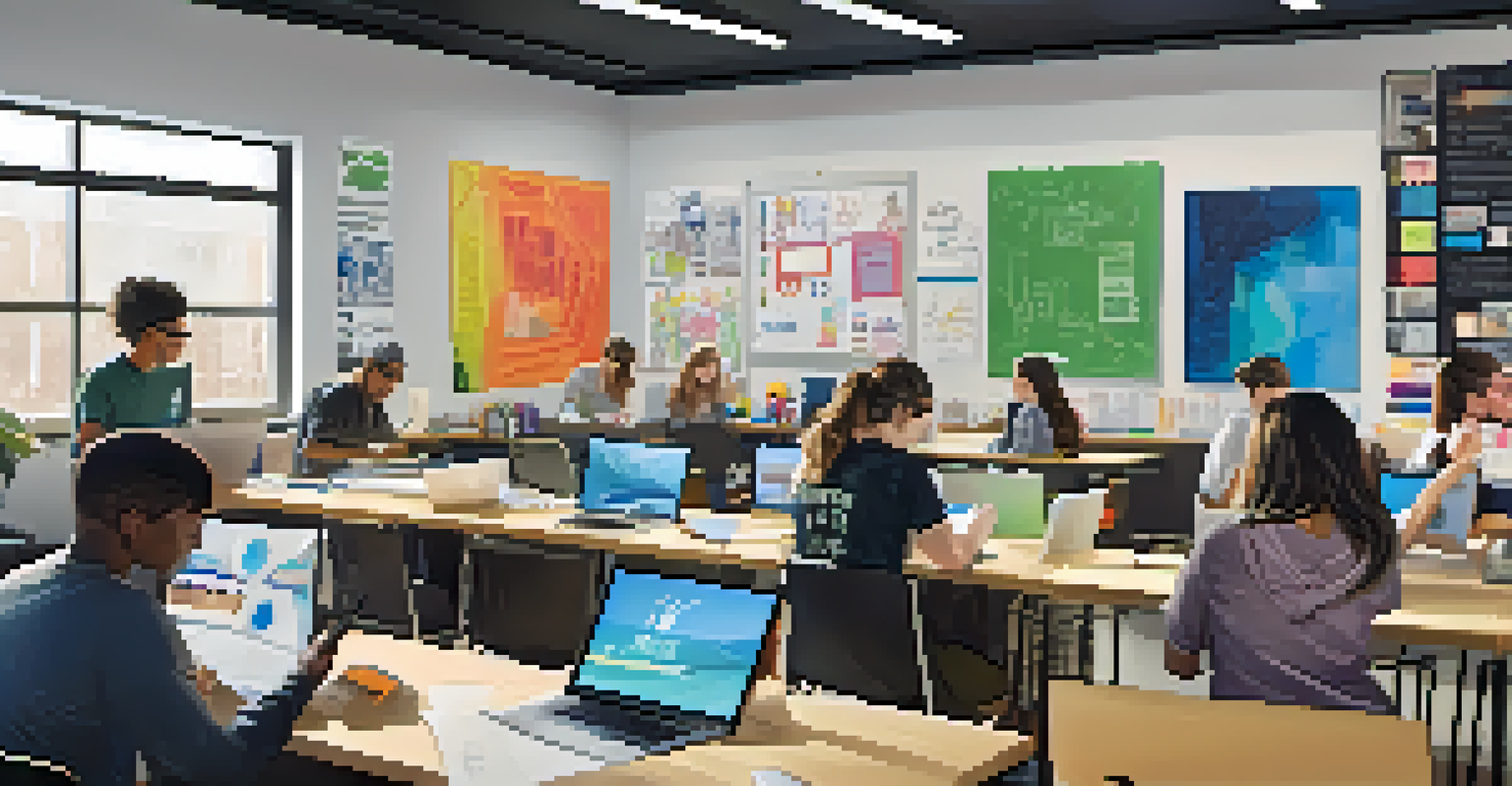Transmedia Learning: Integrating Ethics into Education

Understanding Transmedia Learning in Education
Transmedia learning is an innovative approach that engages learners through multiple platforms and narratives. Imagine a story that unfolds across books, videos, social media, and games, allowing students to explore content from different angles. This method not only captivates attention but also fosters deeper understanding by encouraging students to interact with information in various formats. By integrating transmedia techniques into education, we can create a more immersive and holistic learning experience.
The greatest danger in times of turbulence is not the turbulence; it is to act with yesterday's logic.
At its core, transmedia learning leverages the strengths of different media to enhance comprehension and retention. For instance, students might read a chapter, watch a related documentary, and then participate in an online discussion about the ethical implications presented. This multi-faceted approach caters to diverse learning styles and keeps students engaged, making education not just a task but an exciting journey of discovery.
When implemented effectively, transmedia learning can encourage critical thinking and creativity. As students navigate through different media, they learn to synthesize information, analyze perspectives, and develop their own informed viewpoints. This dynamic process is essential for fostering a generation of learners who are not only knowledgeable but also ethically aware.
The Role of Ethics in Transmedia Learning
Incorporating ethics into transmedia learning is vital for preparing students to face real-world dilemmas. Ethics serves as a compass, guiding learners through the complex landscape of information and choices they will encounter. When students engage with narratives that present moral challenges, they develop the ability to think critically about right and wrong, as well as the consequences of their decisions.

For example, a transmedia project could center around environmental ethics, allowing students to explore various viewpoints through a series of interconnected media. They might watch a documentary about climate change, engage in a debate on social media, and then create a video advocating for sustainable practices. This multifaceted exploration encourages them to grapple with ethical questions from different angles, deepening their understanding and empathy.
Transmedia Learning Enhances Engagement
Transmedia learning captivates students by using multiple platforms to explore content, fostering deeper understanding and interaction.
Moreover, integrating ethics into transmedia learning promotes a sense of responsibility and social awareness. As students examine their roles within larger societal issues, they learn that their actions can have far-reaching consequences. This understanding can motivate them to become proactive advocates for positive change, both in their communities and the world at large.
Designing Ethical Transmedia Learning Experiences
Creating ethical transmedia learning experiences requires thoughtful planning and collaboration among educators, content creators, and students. The first step is to identify the ethical themes that are relevant and resonate with learners. By involving students in this process, educators can ensure that the content is engaging and meaningful, fostering a sense of ownership over their learning journey.
Education is the most powerful weapon which you can use to change the world.
Next, educators should curate a range of media that supports the chosen ethical themes. This might include articles, podcasts, films, and interactive websites that provide various perspectives on the issue at hand. The key is to present diverse viewpoints, encouraging students to think critically and engage in discussions that challenge their assumptions and beliefs.
Finally, assessment methods should reflect the transmedia approach, allowing students to demonstrate their understanding through creative projects, presentations, or reflective writing. By assessing their learning in dynamic ways, educators can capture the depth of understanding and ethical reasoning that students develop throughout the experience.
Engaging Students Through Storytelling
Storytelling is a powerful tool in transmedia learning, especially when it comes to illustrating ethical dilemmas. Narratives can create emotional connections, making abstract ethical concepts more relatable and tangible for students. When learners encounter characters facing moral choices, they are more likely to reflect on their values and the implications of their actions.
For instance, a fictional character's journey through a challenging ethical situation can spark discussions among students about morality, justice, and personal responsibility. By analyzing the character's decisions, students can explore their own beliefs and the factors that influence their choices. This process not only enhances their ethical reasoning skills but also fosters empathy and understanding of diverse perspectives.
Ethics Guide Critical Thinking
Incorporating ethics into transmedia projects helps students navigate moral dilemmas, enhancing their critical thinking and social awareness.
Moreover, storytelling in transmedia allows for multiple endings or outcomes based on different ethical decisions, enabling students to explore the consequences of their choices in a safe environment. This interactive element encourages them to think critically about the repercussions of their actions, both in the narrative and in real life.
The Benefits of Collaborative Learning
Transmedia learning often thrives on collaboration, which can significantly enhance ethical education. When students work together on projects that involve various media, they have the opportunity to share ideas, challenge each other's viewpoints, and develop a deeper understanding of ethical concepts. This collaborative environment fosters respect for diverse opinions and encourages open dialogue.
For instance, group projects that require students to create a transmedia campaign around an ethical issue can lead to rich discussions and innovative solutions. As students brainstorm and critique each other's work, they learn to articulate their thoughts and defend their positions, which strengthens their ethical reasoning skills. Collaboration also helps them appreciate the importance of teamwork in addressing complex societal challenges.
Additionally, working collaboratively can help students develop essential soft skills, such as communication, empathy, and conflict resolution. These skills are crucial when navigating ethical issues in real-world contexts, preparing students to engage with others in constructive ways as they advocate for change.
Challenges in Implementing Transmedia Learning
While transmedia learning offers numerous benefits, it also presents some challenges for educators. One significant hurdle is the need for adequate resources and training to effectively implement this approach. Educators must be comfortable with various media formats and have the skills to integrate them into their teaching while addressing ethical themes.
Moreover, ensuring that all students have access to the necessary technology is crucial for a successful transmedia learning experience. Disparities in access can create barriers that hinder participation and engagement, particularly for students from underprivileged backgrounds. Educators must find creative solutions to bridge these gaps and provide equitable learning opportunities.
Collaboration Boosts Ethical Reasoning
Collaborative transmedia projects cultivate respect for diverse opinions and strengthen students' ethical reasoning through shared experiences.
Lastly, balancing the complexity of transmedia projects with curriculum requirements can be a challenge. Educators need to ensure that while they encourage exploration and creativity, they also meet educational standards and learning outcomes. This requires careful planning and a clear understanding of how to align transmedia experiences with the overall educational goals.
Future Directions for Transmedia Learning and Ethics
As education continues to evolve, the integration of transmedia learning and ethics will likely become increasingly important. With the rise of technology and digital media, educators have the opportunity to explore innovative ways to engage students in ethical discussions. This could include virtual reality experiences, interactive gaming, or augmented reality projects that immerse students in complex ethical landscapes.
Additionally, as global issues such as climate change and social justice gain prominence, the need for ethical education will only grow. Transmedia learning can empower students to understand these challenges from multiple perspectives and inspire them to take action. By equipping students with the tools to navigate ethical dilemmas, we can foster a generation of socially responsible citizens.

Ultimately, the future of transmedia learning lies in its ability to adapt to the changing landscape of education. By continuously exploring new media, methodologies, and ethical themes, educators can create compelling learning experiences that resonate with students and prepare them for the complexities of the world ahead.